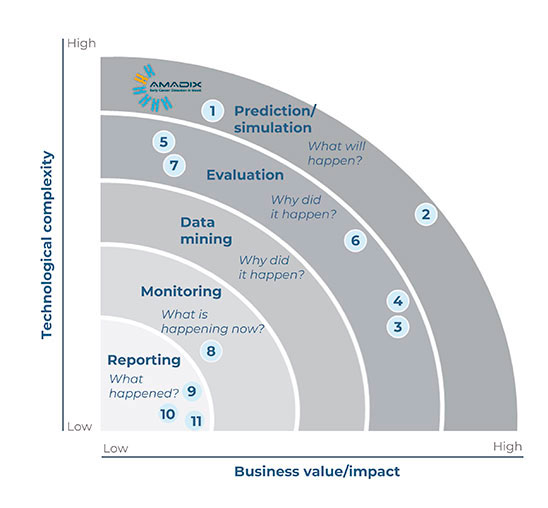

What is artificial intelligence (AI)?
Artificial Intelligence is an umbrella term including a wide range of technologies and applications.
Artificial Intelligence (AI) has been defined very differently throughout the last decade since its development is revolutionizing the 21st century and as a result, there is no widely accepted definition.
The 2018 European Commission[1] defined AI as a system that displays intelligent behavior by analyzing its environment and taking action – with some degree of autonomy – to achieve specific goals.
Meanwhile, the National Artificial Intelligence Initiative Act of 2020 (US)[2] states that the term ‘‘artificial intelligence’’ means a machine-based system that can, for a given set of human-defined objectives, make predictions, recommendations or decisions influencing real or virtual environments. Artificial intelligence systems use machine and human-based inputs to
Today, Artificial Intelligence plays an invisible but important role in everyone’s lives, from powering search engines to making Alexa or Siri from Amazon and Google a reality. But more importantly, it plays an important role in today’s healthcare system, helping society to accelerate the development of life-saving treatments, improving and increasing the accuracy of diagnostics methods, or identifying and selecting patients who can benefit from a specific treatment.
Uses of artificial intelligence in healthcare
The adoption of AI in healthcare is promising. It already helps to simplify the lives of patients, doctors, and hospital managers. This technology has the potential to revolutionize and transform many aspects of patient care and the way we diagnose and treat disease. AI offers several advantages in healthcare, allowing humans to gain unprecedented insight into diagnostics, treatments, and patient outcomes.
Some types of AI are already being used by hospitals, doctors, life sciences companies, and patients. Some examples of them are the following:
Natural language processing (NLP) is one of the most useful forms of AI in healthcare. NLP includes applications such as speech recognition, text analysis, translation, etc. In healthcare it is used to understand and classify clinical documentation and it can also analyze unstructured clinical notes from clinical records and reports. Most patients’ clinical records are written in an unstructured form, so NLP helps us to convert the unstructured form into a structured form to be able to analyze it.
Furthermore, AI is also revolutionizing precision medicine and with the help of this technology doctors are able to provide the correct treatment to the required patients at the right time, having a better selection of patients. The volume of data generated within the health sector has increased exponentially in the last decade, and healthcare systems are taking advantage of new developed AI methods to process such information, whose potential improves the quality of care and patient outcomes.
Some reports have shed light on the development of AI technologies within the healthcare sector, analyzing the ways of implementation of AI, and legislation and policy framework to yield the benefits that AI can bring to healthcare system, specifically looking at patients, practitioners, and enterprises.
- Study on eHealth, Interoperability of Health Data and Artificial Intelligence for Health and Care in the European Union, European Commission, 2021.
- Transforming healthcare with AI, EIT Health & McKinsey & Company, 2020.
- Resolution on Artificial Intelligence in a digital age, European Parliament, 2022.
Amadix

At AMADIX we believe that AI has an important role to play in healthcare, and specifically, it can help us to improve the way we diagnose. AMADIX has foreseen the high potential of Artificial Intelligence and Big Data for developing powerful diagnostic prediction models based on risk factors (beyond age) identified from the patients’ clinical records, which will help us to anticipate the appearance of the disease with higher accuracy.
AI tools (and also natural language processing) will serve AMADIX to anticipate hidden underlying cancer risk factors in order to identify them and develop predictive models to include in the PreveCol® algorithm, in addition to defining new screening populations in which age is not the only the criteria to be eligible. Furthermore, the innovativeness of this proposal also relies on the development of a diagnostic predicting algorithm based on risk factors previously identified by Big Data tools from the analysis of the patients’ clinical records, and that will be validated within the project. This algorithm will make it possible to identify patients with a higher risk of developing cancer, as well as to further improve PreveCol® diagnostic performance.



